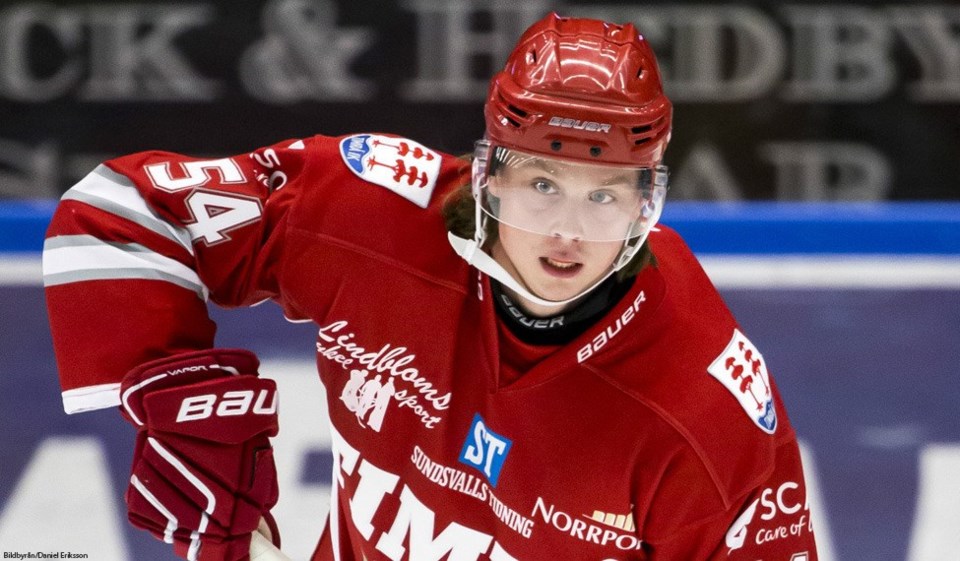When the Canucks drafted Jonathan Dahlen’s teammate with Timrå IK, Elias Pettersson, fans and media alike were quick to make the connection to the Sedins. After all, they’re Swedish teammates playing in a men’s league. They’re both playmakers, but the one that plays left wing leans more towards scoring goals.
I satirically pointed out the absurdity of comparing Petterson and Dahlen to the Sedins after the draft, but let’s say it more explicitly: Petterson and Dahlen are not the Sedins and it’s ridiculous to expect them to live up to the lofty expectations created by such a comparison.
The one who suffers the most by the comparison is Dahlen, who has never been as highly regarded as Daniel Sedin. Dahlen was drafted in the middle of the second round in 2016 by the Ottawa Senators and, despite his tremendous skill level, was pretty firmly in their second tier of prospects behind the likes of Logan Brown and Colin White.
That’s not to take anything away from Dahlen, who has legitimate first-line upside. It’s just an acknowledgement that he’s not in the same class as a future Hall-of-Famer. That isn’t, and shouldn’t be construed as, an insult.
"It's hard to stand here and compare yourself to two of the best players in Swedish history," said Dahlen during development camp. "Of course, they're big idols for every young Swede, they're great players and it's really fun to watch highlights of them. Me and Elias are going to do our best."
Even a quick comparison of Dahlen and Daniel should put the idea to rest in an instant. In the season before their draft year, Dahlen played in the Superelit under-20, where he had a very good season. Daniel, on the other hand, was already in the Swedish Elite League and playing for Sweden in the World Junior Championships.
In their draft years, Dahlen put up a very respectable 15 goals and 29 points in 51 Allsvenskan games. That’s good, but a lower points-per-game average than David Pastrnak and William Nylander in their draft years in the Allsvenskan. Daniel, meanwhile, put up 21 goals and 42 points in 50 games for MoDo in the Swedish Elite League. There’s simply no comparison.
You could, perhaps, compare their performance in their Draft+1 years in the World Junior Championships. Dahlen certainly commanded some attention with 5 goals and 6 points in 7 games. But Daniel had 6 goals and 10 points in 7 games at the same age and had 10 points in 7 games the year before that.
Again, this isn’t to take anything away from Dahlen. Pointing out that he’s not as good as the Canucks franchise leader in goalscoring is not a slight. So, let’s move on from that and take Dahlen for who he is: a tremendous goalscorer in his own right.
Dahlen is capable of putting the puck in the net in multiple different ways, but seems to prefer his slap shot, even deploying it against an unsuspecting Michael DiPietro in the shootout at the Canucks summer showcase. He can beat goaltenders cleanly with the quick release on his wrist shot as well, and he’s not afraid to get to the net either, scoring on quick moves or rebounds.
In fact, Dahlen does some of his best work in front of the net, which is where concerns about his size and strength come into play. Dahlen has been able to hold his own physically in the Allsvenskan, but will face a tougher challenge in the NHL if he wants to make a living at the top of the crease. He’s just 5’11” and 175 lbs currently and will need to add a lot of muscle to win battles in that area.
The other concern for Dahlen is his skating. As much as he has the intelligence and instincts to find soft spots in coverage, he’ll need to be quicker to get to those spots in the NHL. Likewise, will he be fast enough to get to pucks and win the overall possession battle when he’s on the ice? Does he have the size and speed to be an effective player defensively at the NHL level?
Those are the questions he’ll have to answer over the next couple years, whether he comes over to North America to play in the AHL or moves up to the Swedish Hockey League, potentially to play another season with Pettersson.
To his credit, Dahlen was a legitimately dominant player in the Allsvenskan last season. He was third in the league in points-per-game and second in shots, averaging exactly four shots per game. He doesn’t have the same shooting percentage concern as Pettersson, scoring on a good, but reasonable 13.89% of his shots.
He also led the league in missed shots, which may not sound like a good thing, but it means that he had the puck on his stick in the offensive zone a lot.
On top of that, the vast majority of Dahlen’s scoring came at even-strength. He had just 5 goals and 9 points on the power play, meaning he had 20 goals and 35 points at even-strength. He wasn’t dependent on the space provided by the power play to put up points.
While he scored at a slower pace to Pastrnak and Nylander in his draft season, he had a higher points-per-game average than Filip Forsberg in their respective post-draft seasons in the Allsvenskan. The biggest difference is Forsberg has two inches and 30 pounds on Dahlen, but the potential is there for Dahlen to become a 30-goal scorer like Forsberg in the NHL.
Keep in mind, Dahlen was 18 when the season started and was playing in a league against men. It may not have been the SHL, and he certainly benefited from playing with a passer like Pettersson, but he still had an amazing season. Let’s just stop with the comparisons to the Sedins and create some more reasonable expectations.



